
Army and Royal Marines
Fortifications & Barracks - Peacekeeping
The Dockyard's original garrison was provided by Royal Marines. Their first barracks was HMS Dragon,
a beached 74 gun warship which had been seen action before the Battle of Trafalgar.
The marines would have repelled any foreign attackers, but their actual duties included
peacekeeping in the local countryside.
Farmers, frustrated at having to pay to use toll roads, took matters into their own hands. During the
Rebecca Riots (1842-3), midnight gangs - normally led by "Rebecca", a horseman disguised in woman's
clothes - methodically wrecked the tollgates of Southwest Wales. As desperate magistrates
summoned help, the marines were hurried to destinations including Cardigan (by steamer) and St.
Clears - to find smashed gates and, sometimes, a polite note from the elusive Rebecca. The troubles
abated after 1844, and the Marines returned to Dockyard duties.
The yard quickly developed into a national asset, needing well planned protection from enemies. A
network of coastal forts spread out from Pembroke Dock, along Milford Haven. Pembroke Dock itself,
with more barracks and camps, had by World War 1 become Britain's seventh largest garrison town.
(Sources: Mason 80; Peters 10; Williams, Rebecca, 193, 212-4, 230, ;Watts)
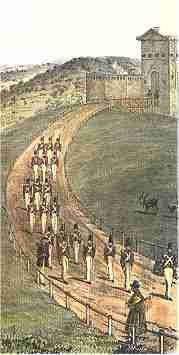
Soldiers march out from the newly built
Defensible Barracks, c. 1848. A
Llangwm girl, with her fish-basket,
looks on.
Picture of Defensible Barracks c. 1848, by courtesy of Pembrokeshire County Libraries

Fortifications & Barracks - Pater Fort
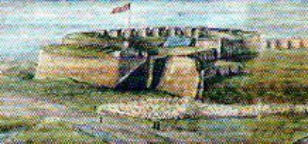
Pater Fort and battery stood in what is now the northwestern corner of the Dockyard, near the
Carr Jetty. Building work began in the 1750s, to defend the Haven at the time of the Seven
Years' War, but the fort was left unfinished. Richard Fenton, viewing this uncompleted, isolated
structure in 1810, thought it "a scandalous waste of public money". Fortifications were rebuilt
here several times as part of the Dockyard's seaward defences "Pater Battery", Mrs Peters notes,
was constructed in 1840-42. Dockyard volunteers and other units trained and drilled here, the
artillerymen firing at targets such as a barrel surmounted by a flagstaff, moored in the haven
about a mile off. Most of the battery was demolished in 1903. Some of its masonry was carried
off by horse and cart, without charge, by Thomas Brown and Joseph Gibby. They carted the
stones from one end of town to the other, to build St. Teilo's church.
(Sources: Fenton 151; CADW 62; Peters 81; HMT 24 May 1871; Mason 213)
Picture by courtesy of Pembrokeshire County Council Museum Service.
Pater Fort c. 1835.

The Defensible Barracks
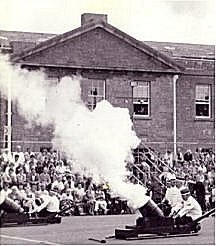
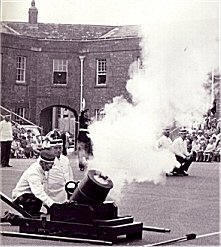
The 1987 Military Tattoo - The Pembroke Dock Volunteer Artillery make the
Defensible Barracks ring to the sound of gunfire once again.
The entrance to this imposing structure bears the date "VR 1844". The
barracks' moat encloses outer walls. Inner barrack blocks are built around
a central parade ground. It first housed the Royal Marines, then - until
after World War II - numerous Army units.
The dry moat proved a hazard to Victorian servicemen returning after
dark from evenings in town, and had to be fenced in.
18 soldiers died here in a 1942 basement mine training accident. They
included three Jewish refugees from Nazi Germany - Corporal Heinz
Abraham, and Privates Ludwig Rosenthal and Heinz Schwartze.
Dominating the Dockyard and town, the Defensible was intended as an
artillery fort as well as barracks. Nearby buildings in Pennar were
demolished to give the weaponry a clear field of fire. In the days of the
Royal Dockyard the artillery served a ceremonial, as well as a defensive,
purpose: 21 gun salutes greeted important anniversaries and Royal
visitors. The discharge of a smaller gun, by the entrance, kept time for
the town. Gunfire time was at noon and 9.30 pm.
(Sources: CADW 37-39; Peters 72; Evans, disaster; Johnson, K. Boom of ...
gun: )
Pictures of Artillery Volunteers by courtesy of Mr R. Watts.
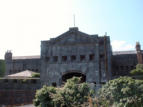
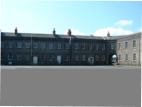
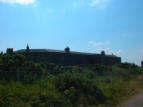

News
The two 1851 gun towers stand at opposite corners of the Dockyard. They,
with the Pater Battery, were for close quarter defence of the yard. Their 32
and 12 lb guns could be swung to fire seawards or, in case of a land attack,
along the straight roads flanking the Dockyard wall. visitors to Front Street
may see the ammunition delivery system - narrow spiral staircases, up
which soldiers would have to carry armfuls of charges as quickly as possible.
In the late nineteenth century the Front Street tower was home for a
sergeant of artillery and his family. Later, it was used for for storage. It was
then refurbished as the town's museum. Now closed with no known plan
(AJ 2016)
The Fort Road tower is also in the process of restoration, as a historic
private dwelling.
(Sources: Watts; Clements 129-133)
The Gun Towers
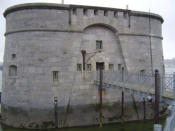
. at Front Street and Fort Road
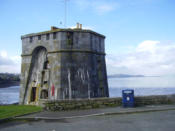
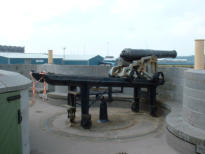
Llanion Barracks
Llanion hut camp was built during the Crimean war emergency. Brick barracks
replaced the wooden huts in the early 1900s. Mrs Peters, writing at the time, notes
with approval "they are built on the most modern principles. At one time soldiers had
to to sleep and eat in the same barrack-room, but in these new buildings a proper
and commodious room is set apart for meals... Each block is provided with a veranda,
where the men can walk out".
Llanion Barracks witnessed the low and high points of World War II. In 1940, Britain's
back was to the wall. One of the few weapons available to the barracks' anti aircraft
gunners was a small Lewis gun. Nazi bombers could attack the town and oil tanks
with virtual impunity. Corporal Arthur Lowe's experiences at Llanion in 1940 may have
helped inspire his most famous role - Captain Mainwaring of Dad's Army.
In 1944, one of the many units training for the Liberation of Europe was
accommodated here. General Eisenhower visited Llanion to inspect the United States
110th Infantry Regiment. Veterans and townspeople alike have happy memories of
this pause in the life of the young soldiers, who were soon to take heavy casualties in
bitter fighting against hardened SS units.
Australian airmen of 461 squadron were also quartered here in world war II. They
travelled and from work in the Dockyard by a fleet of bicycles.
The units stationed in Pembroke Dock are honoured in memorials, histories, and
regimental associations. One of Llanion's last units received a different kind of
recognition. The 22nd Light Air Defence Regiment gave its name to one of the town's
most popular nightspots - the Double Two club.
The fine brick Officers' Mess has provided office accommodation for South
Pembrokeshire District Council and (currently) the Pembrokeshire Coast National
Park.
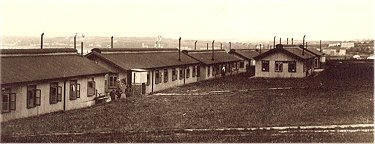
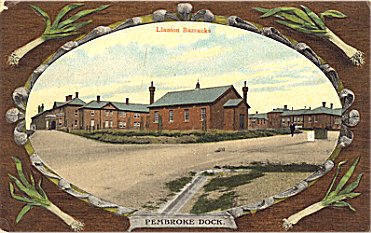

... and Barracks (c. 1905)

(Sources: Peters 80; Scott, Experience shared, 209-230; Hennessey; Ashworth, 149.) Pictures (incl. Zenith postcard) by courtesy of Mr Michael Blake
Pennar Barracks & Bush Camp

Brick barracks were also constructed at Pennar Point. These were
originally a torpedo and submarine mine depot, and became the Royal
Engineers' barracks.
In World War I, an extensive hut and tent camp occupied the site of
today's Memorial Park and Bush Estate.
(Sources: Peters 81; Scott, Gordon's farewell, 43) Picture from private collection


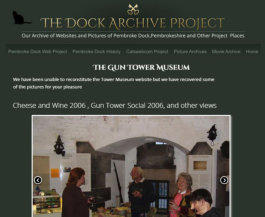
Archived website from when Front Street tower
was the museum click the picture to visit
TOP
HOME
(Amendment, updates and additions) (AJ) Anndra Johnstone
This site is designed, published and hosted by CatsWebCom Community Services © 2018 part of Pembroke Dock Web Project










































